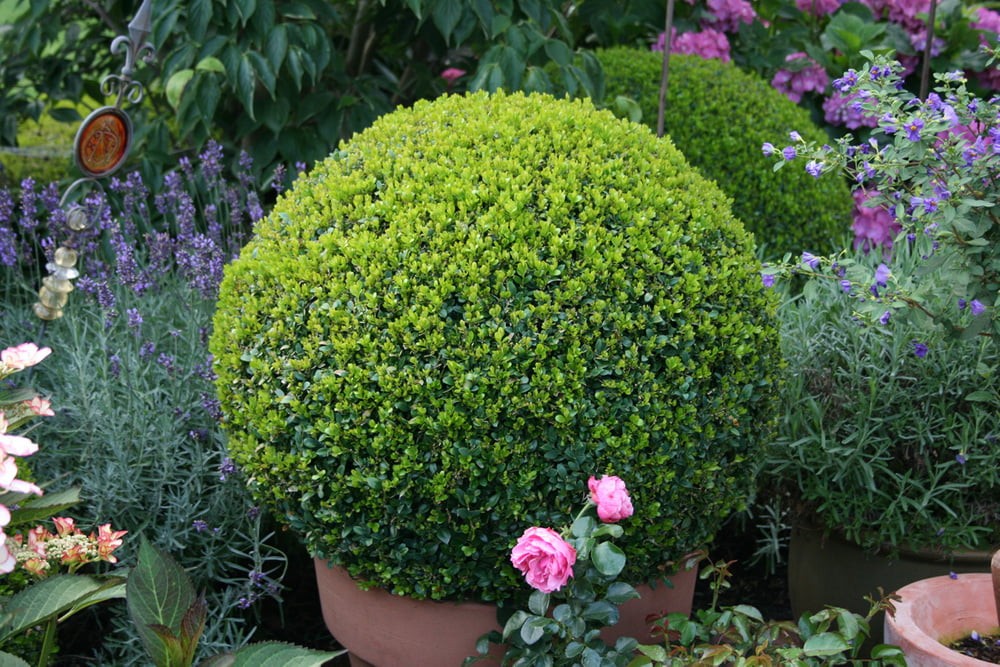Here you can learn what to do about boxwood borer and fungal infestation.
The boxwood (Buxus) is a very special shrub: it grows in a wide variety of soils, in sun and shade, is completely winter-hardy, extremely cut-resistant – and all parts of the plant are poisonous.
Unfortunately, a moth and a fungus are now causing a lot of trouble for what is actually a hardy and robust shrub. We are talking about the boxwood borer and Cylindrocladium buxicola.
But there are many ways to care for the boxwood preventively. This starts with the right location.
Contents
Boxwood: The right location
Although very frugal, the boxwood thrives best in well-drained, calcareous and sufficiently moist loamy soils. The plants tolerate shade, but sunny and airy locations are more favorable. There, wet leaves dry quickly.
As always, sufficient water and regular fertilizing are very important.
From April to early August, you should support the growth of the boxwood in the planter with fertilizer once a week.
In the planting bed, it is sufficient if you fertilize twice, in spring and summer.
Prune boxwood correctly
Proper pruning is also an important contribution to strengthening the plants. You can theoretically prune boxwood monthly from April to September.
Prune only with sharp, clean blades to avoid spreading disease.
Never work when it is raining.
Sunshine could burn freshly exposed leaves.
Optimal time to prune is when the sky is overcast. Learn more about topiary here.
Boxwood: what helps against diseases and pests?
In the event of a pest infestation, it is necessary to act quickly. First, it is important to identify the cause.
Boxwood borer: The yellow-green caterpillars with black and white stripes of the small butterfly eat the plants bare in a short time and cover them with fine webs. With special boxwood borer traps, you will quickly become aware of the annoying pests. You can combat the caterpillars with organic preparations such as “Raupenfrei Xentari”. The agent is gentle to beneficial insects and not dangerous to bees. Important: Two to three generations of small butterflies fly each year.
Fungal infestation (Cylindrocladium buxicola), also boxwood shoot dieback: Brown leaf spots and dark streaks appear first, soon coalescing over a wide area. White spore coating forms on the lower side of the brown leaves. But you can also do something against the aggressive fungal infestation: Preventive as well as curative against the fungus is, for example, “Fungisan Rosen- und Buxus-Pilzfrei”.
If the fungal infestation is already far advanced, no fungicides will help. Then the plant and the foliage must be disposed of completely, for example in the residual waste or by burning.
Caution: If the infested boxwoods end up on the compost, the fungal spores can spread again there. Alternatively, you can have the plants professionally composted.
Tip: If you are not sure whether it is really Cylindrocladium buxicola, you should consult a gardener.
Boxwood: susceptible varieties
Depending on the variety, boxwoods are differently susceptible to attack by pests and fungi. Therefore, if you plan to create a bed border with boxwood, you should choose the right plant.
Particularly susceptible are:
“Blue Heinz”
“Suffruticosa”
Less susceptible are:
“Arborescens”
“Herrenhausen”
“Faulkner”
Boxwood is a favorite target of mealybugs among outdoor plants. Here’s how to recognize mealybugs and how to control them naturally.
American holly (Ilex mersevae) “Little Rascal”: compact growing and densely closed plant, soft and evergreen foliage, very frost-hardy, can also be used as a balcony and container plant.
Japanese Pod (Ilex crenata) “Dark Green”: Very similar to boxwood, good pruning tolerance for ball, cone or pyramid shapes, deep green foliage, very winter hardy
Japanese pod (Ilex crenata) “Caroline Upright”: bushy, low growth, suitable for low hedges, white flowers, black berries, hardy
Tatra daphne (Daphne arbuscula): elongated foliage, low growth, suitable as a border or ground cover, strongly fragrant flower. Caution: Poisonous – just like the boxwood!
Holm Yew (Podocarpus nivalis): slow-growing, shrubby and undemanding dwarf conifer, compact growth, good formability, green needles, very tolerant of pruning and ground cover, ideal as a flat cemetery plant, low hedge or border.


